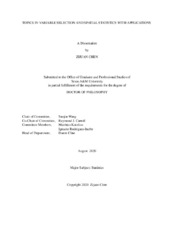| dc.contributor.advisor | Wang, Suojin | |
| dc.contributor.advisor | Carroll, Raymond J. | |
| dc.creator | Chen, Zijuan | |
| dc.date.accessioned | 2021-01-29T17:25:29Z | |
| dc.date.available | 2022-08-01T06:52:48Z | |
| dc.date.created | 2020-08 | |
| dc.date.issued | 2020-06-09 | |
| dc.date.submitted | August 2020 | |
| dc.identifier.uri | https://hdl.handle.net/1969.1/192222 | |
| dc.description.abstract | Spatial random fields are widely used to model the space-time correlation structure of different objects in various fields, such as the soil moisture field in hydrological, agricultural and climatological studies. Since physically derived representations of soil moisture fail to reproduce the fast decay spatial correlation observed in available data, a jitter process is incorporated in the soil moisture model to deflate its correlation structure. An empirical study shows that the new model has successfully captured the spatial-temporal variability of soil moisture at small scales.
We are then able to study the relationship between the soil moisture field and savannas via simulation after the theory of the space-time model of soil moisture has been well established. The sizes of tree clusters in savannas are found to be following power-law distributions in many studies, while the simulation results also indicate that the size of the soil moisture follows power laws. We infer that the power laws with specific exponents observed in the tree cluster data result from the power law of the soil moisture islands when the impact of fire and herbivores is accounted for.
The distribution properties of clusters or islands defined by specific thresholds and underlying spatial random fields, such as the soil moisture islands, are commonly studies in practice. However, there is no applicable statistical methods to analyze this type of clusters. Therefore, we introduce a well-defined distribution function and provide estimation procedure for the function to study the distribution properties of this type of clusters. Numerical experiments and an application to tree clusters data are carried out to validate the results.
Partially linear single-index models are commonly used in the analysis of different kinds of data. We are interested in the extended partially linear single-index models, which is more flexible than the usual partially linear single-index models. We proposed a local smoothing estimators for parameter estimation, and introduced the penalized estimators for variable selection. A chi-squared type of test statistic is also carried out for linear hypotheses. Simulation studies are presented to support our analytic results and a real data analysis is provided for illustration. | en |
| dc.format.mimetype | application/pdf | |
| dc.language.iso | en | |
| dc.subject | distributional properties | en |
| dc.subject | image processing | en |
| dc.subject | lasso | en |
| dc.subject | local smoothing estimator | en |
| dc.subject | partially linear single-index model | en |
| dc.subject | patterns | en |
| dc.subject | savannas | en |
| dc.subject | soil moisture | en |
| dc.subject | spatial statistics | en |
| dc.subject | stochastic process | en |
| dc.subject | tree cluster | en |
| dc.subject | variable selection | en |
| dc.title | Topics in Variable Selection and Spatial Statistics with Applications | en |
| dc.type | Thesis | en |
| thesis.degree.department | Statistics | en |
| thesis.degree.discipline | Statistics | en |
| thesis.degree.grantor | Texas A&M University | en |
| thesis.degree.name | Doctor of Philosophy | en |
| thesis.degree.level | Doctoral | en |
| dc.contributor.committeeMember | Katzfuss, Matthias | |
| dc.contributor.committeeMember | Rodriguez, Ignacio | |
| dc.type.material | text | en |
| dc.date.updated | 2021-01-29T17:25:30Z | |
| local.embargo.terms | 2022-08-01 | |
| local.etdauthor.orcid | 0000-0002-5649-2441 | |


